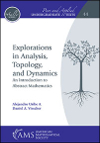- About MAA
- Membership
- MAA Publications
- Periodicals
- Blogs
- MAA Book Series
- MAA Press (an imprint of the AMS)
- MAA Notes
- MAA Reviews
- Mathematical Communication
- Information for Libraries
- Author Resources
- Advertise with MAA
- Meetings
- Competitions
- Programs
- Communities
- MAA Sections
- SIGMAA
- MAA Connect
- Students
- MAA Awards
- Awards Booklets
- Writing Awards
- Teaching Awards
- Service Awards
- Research Awards
- Lecture Awards
- Putnam Competition Individual and Team Winners
- D. E. Shaw Group AMC 8 Awards & Certificates
- Maryam Mirzakhani AMC 10 A Awards & Certificates
- Two Sigma AMC 10 B Awards & Certificates
- Jane Street AMC 12 A Awards & Certificates
- Akamai AMC 12 B Awards & Certificates
- High School Teachers
- News
You are here
Explorations in Analysis, Topology, and Dynamics: An Introduction to Abstract Mathematics

Buy Now:
Publisher:
AMS
Publication Date:
2020
Number of Pages:
178
Format:
Paperback
Series:
Pure and Applied Undergraduate Texts
Price:
85.00
ISBN:
978-1-4704-5270-4
Category:
Textbook
[Reviewed by , on ]
Michele Intermont
01/9/2021
Picking up this slim volume with its conversational tone will make for a friendly beginning to the study of real analysis. But that should not belie its intellectual heft.
This is an inquiry-based learning text. As such, almost all of the statements in the book are left as exercises for the reader. Even some of the definitions are created by the reader after guided examples. This is perhaps the trickiest part, since definitions are the building blocks on which theorems must hang. Luckily, at least for convergence of a sequence, a formal definition is provided in the appendix for use after the initial exploration.
This text includes all the topics one expects to find in the first semester of real analysis, but not to the same depth. This is not surprising, as the development of the ideas generally moves more slowly when students are building much of the framework for themselves. To give some examples, least upper bounds and greatest lower bounds are not introduced as quickly, nor do those terms seem as ubiquitous as in other texts; Cauchy sequences are only included in a section marked as additional topics; L’Hopital’s rule is not mentioned; and more surprisingly, the epsilon-delta definition of limit is just barely mentioned.
The last two chapters, however, differ from most introductory texts. Here, the authors turn to dynamical systems. Then, they continue with the theme of iteration, and their final chapter, Iterating Algorithms and Representations of Real Numbers, ties nicely back to some of the ideas in the first chapter. There is more than enough material here for a first course, including a chapter on the Riemann integral, but not enough for a two-semester course.
Perhaps the biggest challenge for those instructors wishing to use inquiry-based learning is developing suitable materials. In this text, that challenge has been nicely met. This is not simply a list of examples to work out and theorems to prove. Well, it is collection of statements to prove, but it also includes some questions designed to help students think about expanding examples, and comments designed to help students connect ideas. The authors do a nice job, too, of developing expectations of rigor as the text advances. For example, as the book begins, the authors use words more than symbolic language, gradually increasing the amount of symbolic language as the chapters progress.
I don’t think this book will replace the more traditional textbooks for real analysis, but it is a wonderful addition to the literature. It succeeds in its goal of providing a guide for instructors wishing to help students discover real analysis.
Michele Intermont is an Associate Professor at Kalamazoo College. Her area of specialty is algebraic topology.
See the publisher's website.
- Log in to post comments




